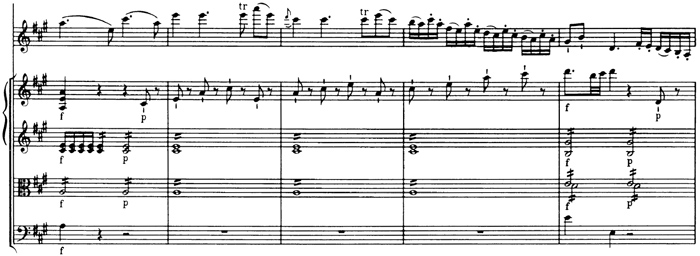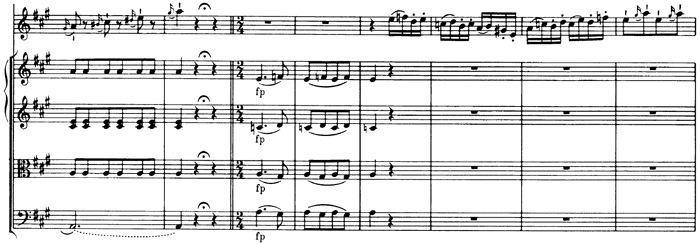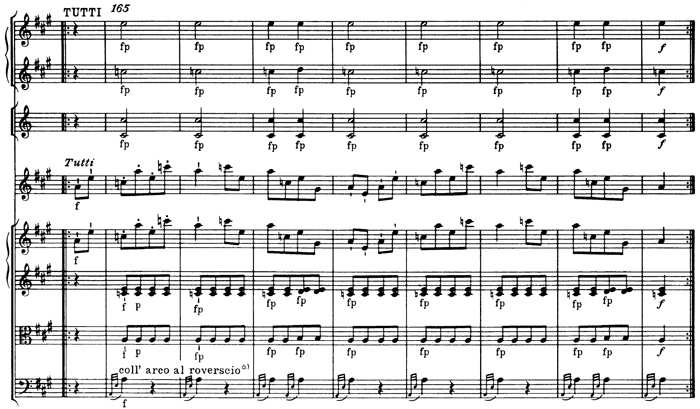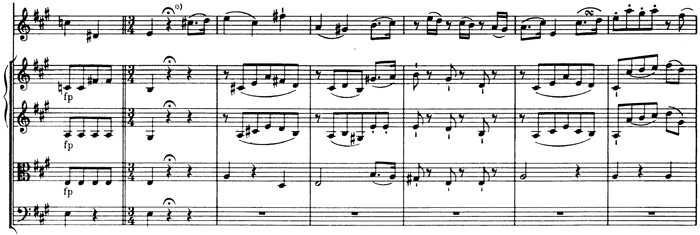Wolfgang Amadeus Mozart
Violin Concerto No.5 in A major, K.219
Media Review / Comparison
2015-02-24 — Original posting
2016-08-03 — Brushed up for better readability
Table of Contents
Introduction / The Recordings
This posting is about the Violin Concerto No.5 in A, K.219, by Wolfgang Amadeus Mozart (1756 – 1791), of which I currently have two recordings:
- Pinchas Zukerman, Saint Paul Chamber Orchestra (1982)
- Vadim Repin, Yehudi Menuhin / Wiener Kammerorchester (2005)
How I Got to Know Mozart’s Violin Concertos
Both these recordings are acquisitions on CD, or digital downloads. In my LP collection (somewhere in the basement, unplayed for at least 30 years), I have the recordings with
- Henryk Szeryng (1918 – 1988, all 5 Mozart concertos with Sir Alexander Gibson and the New Philharmonia Orchestra),
- Arthur Grumiaux (1921 – 1986, again all 5 Mozart concertos, with Sir Colin Davis directing the London Symphony Orchestra).
In addition, I have several LPs with individual Mozart concertos, the concerto in A K.219 is present with
- David Oistrakh (1908 – 1974), playing and conducting the Berlin Philharmonics / Berliner Philharmoniker,
- Shmuel Ashkenasi (*1941), with Edmond de Stoutz (1920 – 1997) directing the Zurich Chamber Orchestra / Zürcher Kammerorchester), and
- Itzhak Perlman (*1945), with James Levine (1943 – 2021) directing the Vienna Philharmonics / Wiener Philharmoniker.
These are all recordings with their definitive merits, but I doubt that from today’s (HIP) perspective it makes sense to have that many non-HIP versions, let alone on top of the two listed above, that I already have on CD now. Mozart violin concertos are among my earliest musical encounters: in my parent’s small LP collection (which I still have somewhere) I seem to remember that there was a recording with
- Manoug Parikian (1920 – 1987)—must have been his recording of the concertos No.1 K.207 and No.5 K.219, with Walter Goehr conducting
However, if I were to add more recordings to my CD collection, it would be in the area of historically informed performances (HIP), rather than reviving any of these.
Background, About the Composition
Wolfgang Amadeus Mozart (1756 – 1791) wrote this concerto between 1775 and 1780. The dating appears somewhat unclear. We don’t know for what occasion, and for whom Mozart wrote these concertos. All violin concertos are joyful compositions. The last one in particular is not just joyful, but at least playful as well, even joking, if not provocative. At the same time it retains popular musical elements. The solo voice is labeled Violino principale and often plays colla parte with the first violin. The idea must have been that the concert master is playing the solo. Mozart did not write down cadenzas for this concerto. However, there is a popular set of cadenzas by Joseph Joachim (1831 – 1907) which many artists choose to play.
The Movements
The Violin Concerto No.5 in A, K.219 has three movements:
I. Allegro aperto — Adagio — Allegro aperto (4/4)
39 + 6 +181 bars, no repeats
The first movement, Allegro aperto, begins with the first violins introducing the main theme. The theme is accompanied by tremolo in the second violin and the viola:
The solo violin is introduced with a sudden change to Adagio in bar 40:
The Adagio section is just 6 bars, ending in a fermata. The “Neue Mozart Ausgabe” indicates that the fermata in bar 45 is to be “ornamented”, i.e., filled with a short cadenza. The purpose of the cadenza is not to make a smooth transition to the Allegro aperto: that part should start as a little surprise. It begins with a repeat of the introduction, this time as accompaniment to the solo part:
The Adagio part does not return, but in bar 219, the soloist has the opportunity for a big cadenza.
II. Adagio (2/4)
128 bars, no repeats
The slow movement is in 2/4 time, i.e., in two beats per bar. This precludes an extremely slow tempo:
The score asks for a solo cadenza in bar 125.
III. Rondeau: Tempo di Menuetto (3/4) — Allegro (2/4) — Tempo di Menuetto (3/4)
Rondeau: Tempo di Menuetto: 131 bars, no repeats — Allegro: 33 + 8 + 8 + 8 + 73 bars, parts 2 – 4 repeated — Tempo di Menuetto: 88 bars, no repeats
The last movement is a Rondo in Tempo di Menuetto. That’s a movement full of surprises. It starts with the soloist introducing the Rondo theme:The soloist has the opportunity for two short cadenzas (bars 58 and 109), each leading back into the Rondo theme. In bar 131, the first section ends with a pause / fermata. The movement suddenly switches from A major to C minor, from a pleasant Menuet in 3/4 to Allegro in 2/4 (annotations and wind instrument voices not shown in the score samples):
The solo marks a rather wild “Romani dance”, then — yet another surprise — after 33 bars, the tone changes again, into a veritable Janitscharenmusik (Janissary music). The cellos and basses must use the bow upside down, i.e., treating the strings with the wooden part of the bow, marking a Turkish marching band. That’s clearly a reverberation from the presence of the Osmans in central Europe, or rather the victory over the Osmans by Prince Eugene of Savoy in 1697:
That “Turkish” section features three 8-bar sections with repeat, followed by a longer segment without repeat. It ends in a fermata in bar 262, where a cadenza leads back to the Tempo di Menuetto / Rondeau:
As in the initial Menuetto segment, the solo has the opportunity to play another short cadenza when the ritornello returns in bar 320. Overall, the “Turkish segment”, counting the repeats and the cadenza, has about the same weight as the actual Menuetto.
The Interpretations
Both interpretations below are non-HIP, i.e., traditional. I really should watch out for a HIP (historically informed playing) version! In both cases, the solo (understandably) is very much central to the recording. In other words: one does not get the impression of the concertmaster (primus inter pares) playing the solo part. But of course, in a CD recording, listeners expect to have a “closer view” on the soloist than in a concert hall.
Pinchas Zukerman / Saint Paul Chamber Orchestra
Mozart: Violin Concerto No.3 in G, K.216; Violin Concerto No.5 in A, K.219
Pinchas Zukerman / Saint Paul Chamber Orchestra
CBS Records MYK 42612 (CD, stereo); ℗ 1982 / © 1987
Booklet: 7 pp. en/fr/de

I have inherited this CD from my parents. I doubt that I would have purchased it otherwise. Still, back in my LP days, in my own view, Pinchas Zukerman (*1948) enjoyed a good reputation, both as a soloist, as well as for his cooperation in chamber music ensembles. He was often appearing with artists such as Itzhak Perlman and Daniel Barenboim. Zukerman plays both the violin and the viola, while also pursuing careers as teacher and conductor. For this recording, the booklet does not include details about the cadenzas played. I assume that for the first two movements he is playing his own cadenzas. There is also no information about his instrument. I assume he is playing the “Dushkin” Guarnerius del Gesù violin of 1742. Zukerman recorded this concerto in 1982.
Notes on the Movements
I. Allegro aperto — Adagio — Allegro aperto (4/4)
Duration: 9’58”; 1/4 = 124 — 1/8 = 46
A traditional recording in all aspects. The tempo is moderate, the articulation is rather broad, both in the orchestra as well as in the solo part. One example: the staccati around bar 80 are clearly portato. Also, the vibrato is omnipresent, particularly in the solo part, especially in the cadenzas. For me, there is definitely too much vibrato, both because it is everywhere, and because it is too strong in amplitude.
One additional, minor point: in bars 133/134 the solo has resting, full notes, while the orchestra has f – p – f – p in both bars. Zukerman follows the orchestra dynamics. Is this just because he is also conducting?? But overall, it’s not a bad recording, with lively playing, assuming one can cope with the vibrato. Zukerman plays both the small cadenza (bar 45), as well as (of course) the big one. I assume that these are his own. I like his first, short one, but I have some reservations about the big cadenza, as it contains some rather strange (non-classical) melodic and harmonic moves. Zukerman’s playing in general (apart from the vibrato) is fine, maybe sometimes rather robust.
II. Adagio (2/4)
Duration: 12’07”; 1/8 = 48
Zukerman’s tone sounds rather sharp, maybe a little aggressive at times even. And again, he plays with lots of vibrato. One problem with strong, ubiquitous vibrato: in slow movements, when the score asks for more expression (espressivo, etc.), one ends up with even more vibrato. For me this goes to the point where it is close to unbearable. But the major problem I have with this interpretation is that the tempo is definitely too slow. It feels as if the movement was played in 4/8 in lieu of 2/4. Also, the flow sometimes appears to come to a halt, is merely dragging along. As already in the first movement, the cadenza (presumably Zukerman’s own) is no more than a moderate fit to the movement.
III. Rondeau: Tempo di Menuetto (3/4) — Allegro (2/4) — Tempo di Menuetto (3/4)
Duration: 9’24”; 1/4 = 110 — 1/4 = 136
Here now, Zukerman plays all 4 of Joseph Joachim’s cadenzas (with very minor adaptations in the short cadenzas 2 and 4), which is definitely a good move. But again, the articulation tends to be (too) broad, the tempo maybe a bit too laid back, the tone of the solo violin sometimes a bit too solid rather than light and elegant.
Overall Duration: 31’29”
Rating (see above for details): 2.7 (3 / 2 / 3) — Certainly not a CD that I would choose to buy, but OK as a traditional recording.
Vadim Repin, Yehudi Menuhin / Wiener Kammerorchester
Mozart: Violin Concerto No.2 in D, K.211; Violin Concerto No.3 in G, K.216; Violin Concerto No.5 in A, K.219
Vadim Repin, Yehudi Menuhin / Wiener Kammerorchester
Erato / Elatus, iTunes download (256 Kbps, stereo); © 1998
Booklet: none with the downloaded files

Vadim Repin (*1971) is one of the prominent violinists of today’s “middle generation”. According to Wikipedia, he was playing the Stradivarius Ruby from 1708 at the time of this recording. Yehudi Menuhin (1916 – 1999) — a former violin child prodigy himself — is directing the Wiener Kammerorchester (Vienna Chamber Orchestra).
This was at the end of Menuhin’s career, and Repin was 27: a fully formed artist personality. So, I assume he was not influenced by Menuhin in his playing. But Repin comes out of the traditional Russian violin school, a pupil of Zakhar Bron (*1947), the famous teacher. And one can feel this in his playing. Menuhin comes from an even older school, so one cannot expect a historically informed performance. Yet, when comparing this recording to Pinchas Zukerman’s above, one can feel that the recent evolution in HIP playing has had an influence on this performance as well. The articulation is somewhat lighter, the tempo more fluid, the vibrato more controlled. Repin’s tone and technique are flawless, superb.
Notes on the Movements
I. Allegro aperto — Adagio — Allegro aperto (4/4)
Duration: 9’58”; 1/4 = 128 — 1/8 = 48
The recording begins with a little hiccup: there is a little cutting error in bar 5 (some 0.2 seconds extra). But that is not overly conspicuous. For the general impression see above. Repin’s tone is big, well-balanced, the articulation lighter, the staccato less broadened than Zukerman’s. The vibrato is ubiquitous, but luckily more moderate in amplitude, and not nervous. Repin plays Joseph Joachim’s big, excellent cadenza. The majority of the violinists must be playing this: if I think about this movement and its cadenza, this is the one which comes to mind. Joachim did not write a cadenza for bar 45. So, Repin leaves the fermata as is. With today’s tendency to add rather than omit ornaments, this may sound unusual. But to me, Repin’s solution (or rather, Joachim’s) appears valid, convincing as well.
II. Adagio (2/4)
Duration: 12’07”; 1/8 = 56
Better tempo (really in 2/4 time, but still Adagio, i.e., calm). There is less vibrato (OK, still too much for me). The tone in the solo part is nicer, and Joachim’s cadenza again is an excellent fit.
III. Rondeau: Tempo di Menuetto (3/4) — Allegro (2/4) — Tempo di Menuetto (3/4)
Duration: 9’24”; 1/4 = 118 — 1/4 = 144
A tad faster than Zukerman, lighter, slightly better, overall. Repin plays all of Joseph Joachim’s excellent cadenzas, carefully and as written.
Overall Duration: 30’18”
Rating (see above for details): 4.0 (4 / 4 / 4) — An excellent performance! If only there was a little less vibrato …
Addendum
As mentioned above, Mozart’s Symphony in C, K.551 was featured in a concert at the Tonhalle in Zurich, on 2015-03-28, with Sir Roger Norrington and the Zurich Chamber Orchestra. See my concert review for Bachtrack.com. As this is in German, I have written up a separate, more extended review in the posting “Norrington & Arabella Steinbacher in Zurich, 2015-03-28“.














